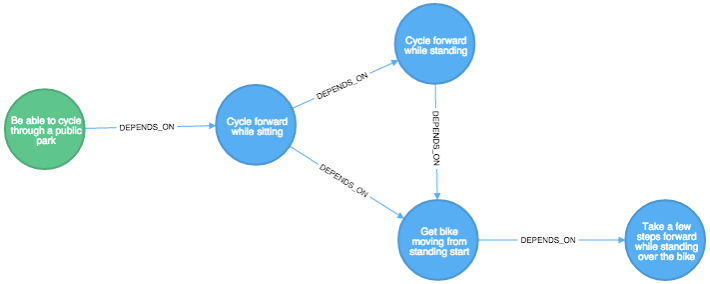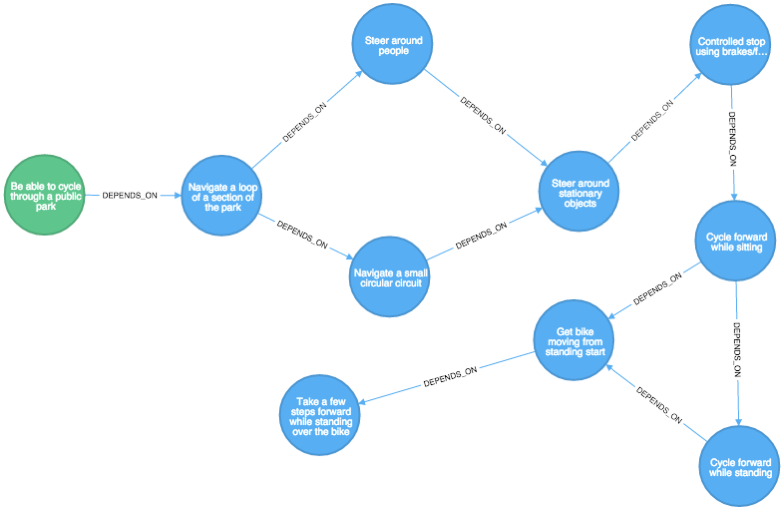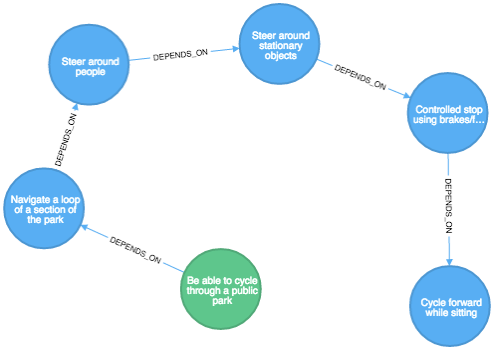Neo4j: The learning to cycle dependency graph
Over the past couple of weeks I’ve been reading about skill building and the break down of skills into more manageable chunks, and recently had a chance to break down the skills required to learn to cycle.
I initially sketched out the skill progression but quickly realised I had drawn a dependency graph and thought that putting it into Neo4j would simplify things.
I started out with the overall goal for cycling which was to 'Be able to cycle through a public park':
MERGE (:Goal:Task {name: "Be able to cycle through a public park"})This goal is easy for someone who’s already learnt to cycle but if we’re starting from scratch it’s a bit daunting so we need to break it down into a simpler skill that we can practice.
The mini algorithm that we’re going to employ for task breakdown is this:
-
Can we do the given task now?
-
Break the task down into something simpler and return to 1.
One of the things to keep in mind is that we won’t get the break down perfect the first time so we may need to change it. For a diagram drawn on a piece of paper this would be annoying but in Neo4j it’s just a simpler refactoring.
Going back to cycling. Since the goal isn’t yet achievable we need to break that down into something a bit easier. Let’s start with something really simple:
MERGE (task:Task {name: "Take a few steps forward while standing over the bike"})
WITH task
MATCH (goal:Goal:Task {name: "Be able to cycle through a public park"})
MERGE (goal)-[:DEPENDS_ON]->(task)In the first line we create our new task and then we connect it to our goal which we created earlier.

After we’ve got the hang of walking with the bike we want to get comfortable with cycling forward a few rotations while sitting on the bike but to do that we need to be able to get the bike moving from a standing start. We might also have another step where we cycle forward while standing on the bike as that might be slightly easier.
Let’s update our graph:
// First let's get rid of the relationship between our initial task and the goal
MATCH (initialTask:Task {name: "Take a few steps forward while standing over the bike"})
MATCH (goal:Goal {name: "Be able to cycle through a public park"})
MATCH (goal)-[rel:DEPENDS_ON]->(initialTask)
DELETE rel
WITH initialTask, goal, ["Get bike moving from standing start", "Cycle forward while standing", "Cycle forward while sitting"] AS newTasks
// Create some nodes for our new tasks
UNWIND newTasks AS newTask
MERGE (t:Task {name: newTask})
WITH initialTask, goal, COLLECT(t) AS newTasks
WITH initialTask, goal, newTasks, newTasks[0] AS firstTask, newTasks[-1] AS lastTask
// Connect the last task to the goal
MERGE (goal)-[:DEPENDS_ON]->(lastTask)
// And the first task to our initial task
MERGE (firstTask)-[:DEPENDS_ON]->(initialTask)
// And all the tasks to each other
FOREACH(i in RANGE(0, length(newTasks) - 2) |
FOREACH(t1 in [newTasks[i]] | FOREACH(t2 in [newTasks[i+1]] |
MERGE (t2)-[:DEPENDS_ON]->(t1)
)))
We don’t strictly need to learn how to cycle while standing up - we could just go straight from getting the bike moving to cycling forward while sitting. Let’s update the graph to reflect that:
MATCH (sitting:Task {name: "Cycle forward while sitting"})
MATCH (moving:Task {name: "Get bike moving from standing start"})
MERGE (sitting)-[:DEPENDS_ON]->(moving)
Once we’ve got the hang of those tasks let’s add in a few more to get us closer to our goal:
WITH [
{skill: "Controlled stop using brakes/feet", dependsOn: "Cycle forward while sitting"},
{skill: "Steer around stationary objects", dependsOn: "Controlled stop using brakes/feet"},
{skill: "Steer around people", dependsOn: "Steer around stationary objects"},
{skill: "Navigate a small circular circuit", dependsOn: "Steer around stationary objects"},
{skill: "Navigate a loop of a section of the park", dependsOn: "Navigate a small circular circuit"},
{skill: "Navigate a loop of a section of the park", dependsOn: "Steer around people"},
{skill: "Be able to cycle through a public park", dependsOn: "Navigate a loop of a section of the park"}
] AS newTasks
FOREACH(newTask in newTasks |
MERGE (t1:Task {name: newTask.skill})
MERGE (t2:Task {name: newTask.dependsOn})
MERGE (t1)-[:DEPENDS_ON]->(t2)
)Finally let’s get rid of the relationship from our goal to 'Cycle forward while sitting' since we’ve replaced that with some intermediate steps:
MATCH (task:Task {name: "Cycle forward while sitting"})
WITH task
MATCH (goal:Goal:Task {name: "Be able to cycle through a public park"})
MERGE (goal)-[rel:DEPENDS_ON]->(task)
DELETE relAnd here’s what the final dependency graph looks like:

Although I put this into Neo4j in order to visualise the dependencies we can now query the data as well. For example, let’s say I know how to cycle forward while sitting on the bike. What steps are there between me and being able to cycle around a park?
MATCH (t:Task {name: "Cycle forward while sitting"}),
(g:Goal {name: "Be able to cycle through a public park"}),
path = shortestpath((g)-[:DEPENDS_ON*]->(t))
RETURN path
Or if we want a list of the tasks we need to do next we could restructure the query slightly:
MATCH (t:Task {name: "Cycle forward while sitting"}),
(g:Goal {name: "Be able to cycle through a public park"}),
path = shortestpath((t)<-[:DEPENDS_ON*]->(g))
WITH [n in nodes(path) | n.name] AS tasks
UNWIND tasks AS task
RETURN task
==> +--------------------------------------------+
==> | task |
==> +--------------------------------------------+
==> | "Cycle forward while sitting" |
==> | "Controlled stop using brakes/feet" |
==> | "Steer around stationary objects" |
==> | "Steer around people" |
==> | "Navigate a loop of a section of the park" |
==> | "Be able to cycle through a public park" |
==> +--------------------------------------------+
==> 6 rowsThat’s all for now but I think this is an interesting way of tracking how you’d learn a skill. I’m trying a similar approach for some statistics topics I’m learning about but I’ve found the order of tasks isn’t so linear there - interestingly much more a graph than a tree.
About the author
I'm currently working on short form content at ClickHouse. I publish short 5 minute videos showing how to solve data problems on YouTube @LearnDataWithMark. I previously worked on graph analytics at Neo4j, where I also co-authored the O'Reilly Graph Algorithms Book with Amy Hodler.
